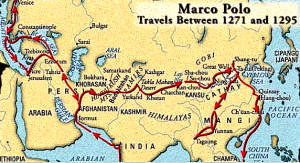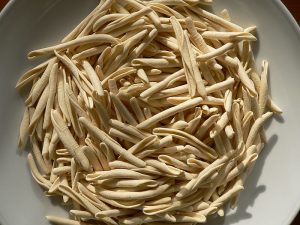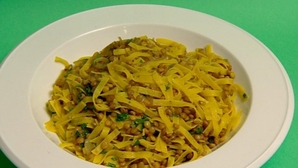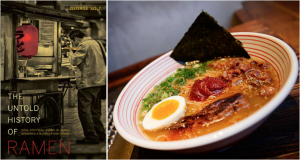You can now hold a plethora of opportunities in the palm of your hands by combining water and flour and kneading them into a dough. Noodles are the definition of adaptability and versatility, and it is this adaptability that has helped them become a well-known food around the world. Noodles are consumed in a variety of ways around the world, including as pho in Vietnam, chow-chow in Nepal, seviyan in India, and many other combinations. Despite the fact that everyone agrees that noodles are popular, the origin of the dish is still hotly contested. There are many competitors who have asserted to be the Noodle’s inventors. Chinese claim to have created this culinary phenomenon, while Italians claim to have invented this plant-based food. In this essay, I’ll try to track down the origins of this cereal food and then try to put an end to the long-standing argument surrounding it.
We start our historical investigation in China, an East Asian nation. It is thought that noodles first appeared here as “Bing” during the early Han Dynasty. After that, they were varied through experimentation and the development of new shapes and cooking techniques. Noodles also rose to prominence in Chinese superstitions and folklore concerning “health, religion, and the economy.” However, given recent archeological discoveries, it’s likely that noodles existed well before the establishment of the Han Rule (Zhang and Ma, 2016). Wheat grains and early production tools were discovered at excavation sites dating back to the early to late Neolithic period, an astounding ten thousand years ago. In 1999, additional concrete proof that Noodles existed for a very long time was discovered. At the Lajia archaeological site in Minhe County, Qinghai Province, noodles were found among artifacts. ‘The noodles and bowl of noodles’ were discovered at the site, and after radio-dating them, it was discovered that they were made and cooked around four thousand years ago, in the early Xia Dynasty. As a result, these archaeological discoveries give us tangible proof from times long ago to the present. They demonstrate how deeply ingrained the noodle is in Chinese culture and culinary traditions, dating back thousands of years. (Wei et al. , 2017).
At the Lajia archaeological site, noodles and a bowl of noodles were found in 1999.
Italy is the next country we visit in this culinary dissertation. The Italian diet and culture are inextricably linked to pasta. The diversity of its forms, which range from tiny pinwheels to enormous sheets, is evident throughout the various parts of this united country. As a result of the geographical constraints and outside influences that have shaped each Italian province’s rich history with pasta, the distinctive foods that are indigenous to these regions have come to symbolize their distinct cultures. Pasta’s introduction to Italy was once credited to Venetian explorer Marco Polo. He traveled to China and returned in 1295 with an abundance of spices and other discoveries, including noodles. (Jackson, P. Nevertheless, there is substantial disagreement with this claim, as shown by the comments made by Justin Demetri in his article “The History of Pasta – Pasta through the Ages.” Although Marco Polo accomplished some amazing feats during his travels, bringing pasta to Italy was not one of them because noodles were already present at the time. ’(Demeteri, 2018).
 Map outlining Marco polo’s travels from Venice to China.
Map outlining Marco polo’s travels from Venice to China.
One of the main objections was that pasta was already present in the Roman and Etruscan eras under the name “Lagane.” The famous Roman poet Quintus Horatius Flaccus, also known as Horace, who wrote, “I come back home to my pot of leek, peas, and laganum,” lends credence to this viewpoint. He wrote the aforementioned piece to refute claims that he was making an effort to blend in with “higher society.” This simple meal of pasta and vegetables was intended to reflect his own modest character. Although it is unknown if these verses were successful in proving Horace’s innocence, it is undeniable that they are among the earliest literary references to Italian pasta. (Ullman, n. d. Horace’s first book is approximately two thousand years old and was written around 34.4 BC. It’s interesting to note that the pasta available during the Etrusco-Roman era, which was made by combining various cereals and water, was baked in an oven rather than boiled. We can use Apicius’ example to illustrate the point about how common pasta was in ancient times. He was a Roman author as well, and his discourse from the first century AD included a discussion of a recipe for “laganon.” (Food-info. net, 2018) These written accounts date back thousands of years. Thus, pasta has long been a part of the Italian diet.
Roman lyric poet Quintus Horatius Flaccus lived from 8 December 65 BC to 27 November 8 BC.
Roman recipes were collected in Apicius, which was published in the first century AD.
Another hypothesis put forth claimed that the Arabs were responsible for the invention and dissemination of boiled noodles, also known as “itriyah.” When they invaded Italy in the eighth century AD, they had a big impact on the country’s cuisine and culinary customs. Regions like Sicily, where the spread of savory and sweet foods like pasta con la sarde was observed after the Arab conquest, adopted their cuisine and culture. At this time, Sicilians had a general admiration for Macaroni as well. (Italy’s Culinary Heritage, n. d. The Jerusalem Talmud, which was written in Aramaic in the fifth century AD and uses the term “itriyah,” is the first clear Western reference to boiled noodles, according to American historian Charles Perry, who specializes in tracing the history of pasta. Later, he claims that during the 10th Century, the term “itriyah” only applied to dry noodles and excluded fresh ones. The Talmud also discussed the term “rihata” for boiled flour and honey, which later gave rise to the word “rishta” for noodles (Giacco, 2016). Since ancient times, the term “rihata” has been discussed and mentioned in scholarly works. Thus, the Arabs have a strong claim that they had a significant impact on the dominance of pasta in the diets and hearts of the Italian people. (Cooper, 1935).
 Itriyah – pasta as mentioned in the Talmud.
Itriyah – pasta as mentioned in the Talmud.
 Rishta (Pasta) cooked with lentils and caramelized onions.
Rishta (Pasta) cooked with lentils and caramelized onions.
Moving further east from China, we now travel to Japan. Ramen is a cultural marvel as well as a culinary phenomenon in this country. Ramen stalls can be found all over Japan, and there are television cooking programs centered around this spicy broth and noodles. There is no one else who consumes Ramen on the scale that Japan’s citizens do. These details raise the questions, “Who are the ancestors of these instant noodles?” and “Has this curry-flavored noodle dish existed in Japan before?” Further investigation reveals that ramen originated in China and was brought to Japan as noodles. Chinese chefs who immigrated to Japan started working and preparing noodle dishes at neighborhood restaurants. The Japanese people then developed a widespread reputation for these foods and held them in high regard. They had developed a craving for the food, and the only way to satisfy that craving was to mechanize the industry. In modern times, ramen has established itself as a staple food in post-World War II Japan. Noodles weren’t invented here, but they have nonetheless contributed significantly to the nation’s identity and become its citizens’ preferred food. (Solt, 2014).
How did ramen come to be the national dish of Japan? is the subject of George Solt’s book, The Untold History of Ramen.
We’ll now examine how the Greeks influenced Italian cuisine, particularly pasta. The regional cuisines of Italy underwent changes as a result of these Mediterranean people and their customs, such as in Puglia where Greek cuisine flourished. Because there wasn’t much meat available in this area, high-quality sausage products and cheeses were used instead. (Italy’s Culinary Heritage, n. d. There is a legend that describes the making and development of pasta. A man named Macareo adopted a Greek woman named Talia as his muse. According to rumors, she gave him the idea to build an iron machine that could make long strands of pasta to feed starving poets. Then, for several years, this discovery was kept a secret before being revealed to the founder of Naples in the sixth century BC. Additionally, tools used to make pasta were discovered in the fourth century BC. These were discovered in a tomb in Rome, and later analysis of the carvings revealed that they date from the pre-Etruscan period. Thus, the existence of these tools indicates that pasta making has been practiced in Italy for a very long time. (Shelke, 2016).
The restaurant’s Da Vinci’s menu includes a description of the Talia and Macareo legend.
After researching the history of pasta from various nations, I believe China to be the noodle’s most likely birthplace. The most encouraging evidence points to this Asian nation as the “inventors” of this straightforward dough made from wheat and water. Horace’s references to the “lagane” were made two thousand years before the noodle remains and bowl were discovered. China truly prevails in the argument because of its physical and archeological evidence, which predates even the written accounts of pasta from Italy, Arabic, and the Mediterranean region. However, even though China may have been the origin of noodles and may have introduced them to some nations, such as Japan and India, it doesn’t necessarily follow that they were the ones to do the same for the rest of the world. Pasta was popular in Italy long before Marco Polo returned with the trade secrets for Chinese noodles. It is not appropriate to make any generalizations about the origin of Italian pasta because there is very little information that has been recorded and only a small number of preserved artifacts. It is also conceivable that pasta originated spontaneously at different times in China and Italy. At some point in the future, new information is certain to come to light that will provide more specific and trustworthy sources with information about who first introduced the noodle to the Italians.
Although every country takes this dough and shapes it in accordance with its own history, culture, and terrain, in my opinion, noodles are all made with the same basic ingredients of flour and water. As a result, each noodle is distinct from the others, and these noodles do not fall into any particular category. In conclusion, I’d like to put forth the idea that there is no one “true” inventor of the noodle because it is a global dish that is constantly being changed and altered through interactions between different countries, ingredients, and people.
For many Americans, pasta has become a staple food, but making noodles and pasta at home is still relatively uncommon. Noodle-making ought to gain popularity as the trend toward making things from scratch continues among some people in the United States. And with just a few more steps, it’s almost as simple to make bread or pie crust.
Jen Lin-Liu, the author, traveled from Beijing to Rome to investigate the origins and dissemination of the well-known food item, and she also savored some delectable surprises along the way.
All I can say is that I’ve condensed my favorite recipes into a dozen or so in my book, which includes dumpling and noodle dishes from China to Italy as well as a few accoutrements like Turkish rose borek (phyllo dough stuffed with leeks, feta, and honey) and Persian braises like fesenjun (chicken simmered in walnut and pomegranate sauce). To narrow them down any further would be too torturous.
Noodles are also mentioned for the first time in the Jerusalem Talmud, which dates from the fifth century A. D. , and was known as itrium; many centuries later, Syrian physicians described a string-like pasta known as itrium made of semolina and dried before cooking.
One of my trip’s most fascinating experiences was that. I had to take a tour guide who was essentially a government minder when I was in Iran. We came across a cooking school for women only, and the women running it invited me inside to learn how to prepare Persian dishes with them, so I was able to get away from him. Women were permitted to dress however they pleased and freely discuss the restrictions that the Islamic government had placed on their lives because the school was located in a private home. Aside from discovering some delicious Persian rice dishes (and a few noodle dishes that weren’t quite right), I discovered that many Iranian women are strong and career-oriented despite having to deal with many daily annoyances like wearing the hejab and being unable to freely interact with men, even in private.
One of the main objections was that pasta was already present in the Roman and Etruscan eras under the name “Lagane.” The famous Roman poet Quintus Horatius Flaccus, also known as Horace, who wrote, “I come back home to my pot of leek, peas, and laganum,” lends credence to this viewpoint. He wrote the aforementioned piece to refute claims that he was making an effort to blend in with “higher society.” This simple meal of pasta and vegetables was intended to reflect his own modest character. Although it is unknown if these verses were successful in proving Horace’s innocence, it is undeniable that they are among the earliest literary references to Italian pasta. (Ullman, n. d. Horace’s first book is approximately two thousand years old and was written around 34.4 BC. It’s interesting to note that the pasta available during the Etrusco-Roman era, which was made by combining various cereals and water, was baked in an oven rather than boiled. We can use Apicius’ example to illustrate the point about how common pasta was in ancient times. He was a Roman author as well, and his discourse from the first century AD included a discussion of a recipe for “laganon.” (Food-info. net, 2018) These written accounts date back thousands of years. Thus, pasta has long been a part of the Italian diet.
 Map outlining Marco polo’s travels from Venice to China.
Map outlining Marco polo’s travels from Venice to China.
 The Untold History of Ramen – Book by George Solt, which aims to answer the following question ‘How did ramen become the national food of Japan?’
The Untold History of Ramen – Book by George Solt, which aims to answer the following question ‘How did ramen become the national food of Japan?’
Although every country takes this dough and shapes it in accordance with its own history, culture, and terrain, in my opinion, noodles are all made with the same basic ingredients of flour and water. As a result, each noodle is distinct from the others, and these noodles do not fall into any particular category. In conclusion, I’d like to put forth the idea that there is no one “true” inventor of the noodle because it is a global dish that is constantly being changed and altered through interactions between different countries, ingredients, and people.
 Rishta (Pasta) cooked with lentils and caramelized onions.
Rishta (Pasta) cooked with lentils and caramelized onions.
Noodles aren’t mentioned in the Mediterranean until about five centuries later, according to Santich (who also reminds aspiring food historians that Italy didn’t become the Kingdom of Italy until the 1860s).
However, Santich’s historical dates differ somewhat. The earliest records of noodles, according to her, date back to China in the fifth century [500-401] BC.
American food writer Jen Lin-Liu embarked on a six-month fact-finding trip from Beijing to Rome in 2010 and 2011 in an effort to shed some light on the nebulous question of whether noodles and pasta are actually Italian or Chinese. The American arrived in Italy after traveling along the Silk Road, a historic trade route that connected China with Central Asia, Iran, Turkey, and Greece.
But based on my travels, it appears that Chinese noodles spread throughout Asia, including Korea and Japan, all of Central Asia, and Turkey. It makes sense because that is how migration patterns and trading routes were at the time. ”.
According to Lin-Liu, it has to do with the word “noodle” itself. Lin-Liu explains, “‘Noodles’ is a tricky term that was invented by the west and implies a long stringy substance. However, a noodle is not referred to as a ‘noodle’ in China as it is in the west. It is called ‘miàn’ or ‘mein’. Miàn is based on the fact that the food you are eating is made from flour in a liquid rather than on the appearance of the food. In this sense, ravioli and dumplings are both màn. ”.
FAQ
Who invented noodles first?
Wheat dough noodles became a popular dish for the people of the Han dynasty. Noodles were first documented 4,000 years ago in China. At the Lajia archaeological site, a group of archaeologists discovered an earthenware bowl in 2005 that contained 4000-year-old noodles.
Where did noodles get invented?
Noodles or pasta are mentioned for the first time in writing in Chinese texts from about 3200 years ago. It is likely that pasta originated in China and the Middle East within a few hundred years ago, according to author Jen Lin-Liu.
Did China or Italy invent noodles?
Long before pasta was introduced to the Mediterranean region, noodles were popular in China and Asia. According to legend, Marco Polo brought pasta from China to Italy in the 13th century.
How did noodles get invented?
Noodles are mentioned for the first time in history in a dictionary from the third century A. D. in China. However, the earliest Chinese noodles were made from bread dough and were shaped into tiny bits before being dropped into a wok of boiling water.